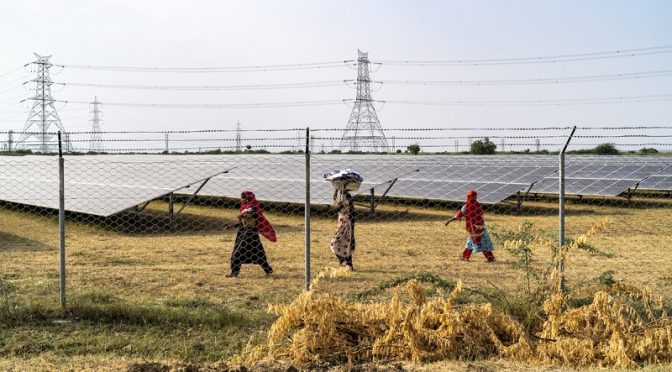The higher incentives offered by Odisha have attracted Saatvik Solar, one of India’s largest solar module manufacturers, to set up its cell and module manufacturing project in the eastern state while putting its plans in Gujarat on the back burner.
“We had purchased a 60-acre land for a solar project at Gandhidham in Kutch district about 2-3 years ago. We are not setting up the project now. The land is 60 kilometres from Kandla port and also very close to Mundra port. In Odisha too, we have a similar sized land where we are going ahead with a cell and module manufacturing plant,” said Prashant Mathur, CEO of Saatvik, which has taken up space in the Tata Steel-operated Special Economic Zone at Gopalpur, which is close to ports like Paradip and Vizag.
The Ambala-based company is investing Rs 2,000 crore in phase 1 of the Odisha project, which involves 2.5 GW of cell manufacturing capacity and 4 GW of module manufacturing capacity. “For cell manufacturing, we need three important things – electricity, water and an effluent treatment plant. Odisha has promised a steady supply of electricity and water at low prices. For ETP, the Odisha government is providing the infrastructure. Odisha offers better incentives and has better policies. Our land is close to the port, so we can export and import and that is why we have chosen Odisha… We will consider setting up an ancillary project in Gujarat in the future. At the moment we will not be able to set up a cell project in Gujarat. We might consider setting up an ancillary project in Gujarat, possibly for wafer or ingot manufacturing in the future,” Mathur said during a recent interaction in Ahmedabad.
Mathur said India’s solar PV manufacturing market was highly competitive and “Gujarat has been a key state for us. So are other states,” he quipped, adding that the “cost of production” in Odisha would be much lower compared to Gujarat. “We had evaluated the costs,” Mathur added.
Closer home, Grew Energy, the solar energy arm of the Gujarat-based Chiripal Group, this year shifted its proposed Rs 4,500-crore solar manufacturing unit from Gujarat to Jammu. In May 2024, the company started construction of its facility in Kathua, where a 3.2 GW manufacturing unit for high-efficiency solar modules and a 2.8 GW unit for ingots, wafers and cells will be built.
“The initial plan was to set up the project in Dholera, Ahmedabad. But we chose Jammu because there is huge government support for setting up solar parks in Ladakh and Uttar Pradesh. We have a committed timeline with the central government under the PLI scheme, so we did not want to delay it further. Vinay Thadani, Director, Grew Energy Pvt Ltd, said earlier about the project which is expected to go live in the first quarter of 2025-26.
Waaree Energy, which is raising an IPO, plans to expand (Chikhli facility) one of its four solar module manufacturing facilities in Gujarat and also set up a 6 GW integrated facility for manufacturing of ingots, wafers, solar cells and PV modules in Odisha.
Among the states, Gujarat continues to be among the top three states in solar module manufacturing along with Rajasthan and Tamil Nadu, while in solar cell manufacturing, Telangana, Gujarat and Himachal Pradesh were among the top states during the calendar year 2023, according to Mercom India Research. By fiscal year 2024, India’s cumulative solar module manufacturing capacity reached about 63 GW, led by Waaree Energies, Adani Mundra PV, ReNew Power, Saatvik and Vikram Solar. In comparison, cumulative cell manufacturing capacity is just about 13 GW.

India’s solar module manufacturing capacity can exceed 70 GW by 2027: IEA
The project pipeline of the production linked incentive (PLI) scheme, under which India is offering around $2.5 billion for expanding solar PV module manufacturing, suggests that its domestic production capacity can surpass 70 gigawatts (GW) by 2027.
“India aims to continue expanding its production capacity to meet domestic needs and to export solar modules: projects in the pipeline under the PLI scheme suggest that its manufacturing capacity could exceed 70 GW per year by 2027,” the International Energy Agency (IEA) said in its latest world energy outlook report.
India, which accounts for 3 per cent of the global solar PV market, is expected to meet its 2030 target to have half of its electricity capacity be non-fossil well before the end of the decade, it added.
Solar manufacturing today is highly concentrated in just five countries accounting for over 90 per cent of global capacity. China is far and away the largest, with the capacity to produce solar modules with an output of over 500 GW every year, equivalent to 80 per cent of world manufacturing capacity.
The other four are Viet Nam (5 per cent of the global market), India (3 per cent), Malaysia (3 per cent) and Thailand (2 per cent). The next five leading solar manufacturers — the US, Korea, Cambodia, Türkiye and Chinese Taipei — each account for around 1 per cent of the global total, as does the European Union.
Solar manufacturing
“If the new solar PV module manufacturing capacity under the PLI programme comes fully online by 2026, it would progress the solar PV module manufacturing capacity in India to well over what is needed until the end of this decade not just in the Stated Policies Scenario (STEPS) but also in the Announced Pledges Scenario (APS),” the IEA projected.
Solar PV module imports could continue for a few years because developers will source the cheapest panels available, as the capacity utilisation factor remains lower than the nameplate capacity, and there are lags between the nameplate capacity coming online and the panels being manufactured, shipped and installed, it said.
In FY22, India imported solar PV modules worth $3.4 billion.
Nonetheless, as domestic production ramps up, solar PV module imports will decline and it will help establish India as a reliable exporter, the IEA projected.
Growing demand
The IEA report projects that the annual electricity demand growth of around 5 per cent puts India behind only China and the US in terms of electricity consumption by 2050 in all scenarios.
China is the largest electricity consumer in the world, and a demand growth of over 2 per cent on average per year to 2050 means that it uses twice or more electricity as any other country, by 2050.
Rising temperatures in India has led to growing use of air conditioners, with electricity consumption from space cooling increasing 21 per cent during 2019-2022. At present, nearly 10 per cent of electricity demand comes from space cooling requirements.
“Fuelled by its geographic and meteorological conditions, air conditioner ownership in India has been steadily rising with growing incomes, tripling since 2010 to reach 24 units per 100 households,”the report projected.
Residential electricity demand from cooling increases ninefold in the STEPS by 2050. By 2050, India’s total electricity demand from residential air conditioners in the STEPS exceeds total electricity consumption in the whole of Africa today.
Under APS, however, electricity demand for air conditioners is nearly 15 per cent lower in 2050 as it is in the STEPS as a result of increased use of energy-efficient air conditioners and thermal insulation in buildings. This reduction itself is larger than the total electricity generation by several countries today, such as that of the Netherlands, it added.


